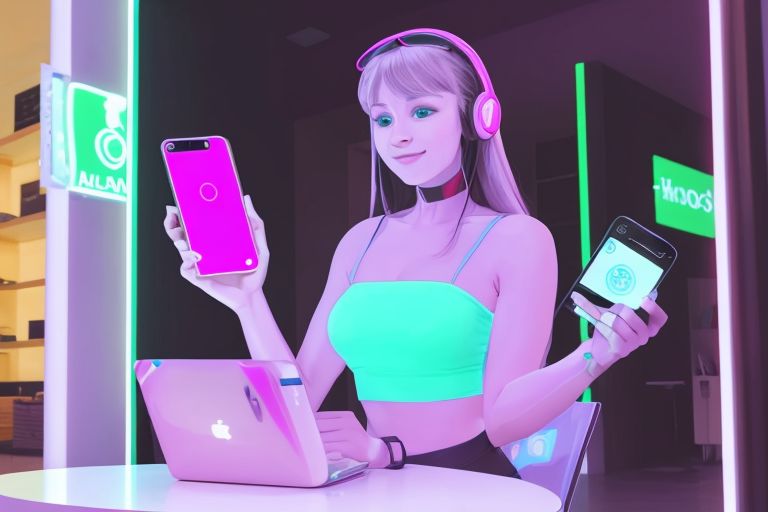The Rise of Online Shopping and the Introduction of AR Technology in E-commerce
Online shopping has become an increasingly popular way for consumers to purchase goods and services. With the convenience of shopping from the comfort of their own homes and the ability to easily compare prices and products, it’s no wonder that online shopping has seen such a significant growth in recent years. In fact, according to a report by eMarketer, global e-commerce sales are expected to reach $6.5 trillion by 2023.
E-commerce sites have played a significant role in enhancing the online shopping experience. They have made it easier for consumers to find the products they are looking for, compare prices, and read reviews from other customers. However, with the introduction of augmented reality (AR) technology, e-commerce sites are taking the online shopping experience to a whole new level.
AR technology allows consumers to see and interact with virtual objects in the real world. This technology has been used in various industries, including gaming, education, and healthcare. In e-commerce, AR technology is being used to create a more immersive and interactive shopping experience for consumers.
In online fashion stores, AR technology is being used to allow customers to try on clothes virtually. By using their smartphone camera, customers can see how a particular outfit would look on them without having to physically try it on. This technology has the potential to revolutionize the way customers shop for clothes online, as it allows them to see how a garment fits and moves on their body before making a purchase.
Similarly, in furniture stores, AR technology is being used to allow customers to see how furniture would look in their homes. By using their smartphone camera, customers can place virtual furniture in their real-world environment and see how it would look before making a purchase. This technology has the potential to reduce the number of returns and increase customer satisfaction by allowing customers to make more informed purchasing decisions.
There are already several examples of e-commerce sites using AR technology to enhance the shopping experience. For example, IKEA has an AR app that allows customers to see how furniture would look in their homes, and Sephora has an AR app that allows customers to try on makeup virtually.
However, there are also challenges in implementing AR technology in e-commerce. One of the challenges is ensuring accessibility for everyone. Not all customers have access to the latest smartphones or the internet speeds required to use AR technology. Another challenge is making sure that AR technology enhances the shopping experience and is not just a novelty. E-commerce sites must find a balance between novelty and usefulness to ensure that customers continue to use the technology.
Despite these challenges, the future of AR in e-commerce looks bright. As technology continues to advance, we can expect to see more sophisticated AR technology being used in e-commerce. AR technology also has the potential to play a role in sustainable and ethical consumption by allowing customers to see the environmental impact of their purchases.
Enhancing the Online Shopping Experience with AR Technology
Augmented reality (AR) technology is revolutionizing the online shopping experience by allowing customers to try on clothes virtually and see how furniture would look in their homes. Online fashion stores like Uvanni are using AR technology to enhance the online shopping experience for customers. By using AR technology, customers can try on clothes virtually and see how they would look on their body without having to leave their home. This feature allows customers to make more informed purchasing decisions and reduces the likelihood of returns.
AR technology is also being used in furniture stores to help customers visualize how furniture would look in their homes. Customers can use their smartphones or tablets to see how a piece of furniture would fit in their space before making a purchase. This feature is especially useful for customers who are hesitant to buy furniture online because they are unsure if it will fit in their home. By using AR technology, customers can make more informed purchasing decisions and have a better online shopping experience.
One example of a customer who has benefited from using AR technology is Frankie. Frankie was shopping for a new outfit online but was unsure if the clothes would fit her body type. She decided to try on the clothes virtually using AR technology and was able to see how they would look on her body without having to leave her home. This feature allowed Frankie to make a more informed purchasing decision and increased her satisfaction with the online shopping experience.
Another example of a customer who has benefited from using AR technology is a son who was shopping for furniture online. He was unsure if a particular piece of furniture would fit in his living room, so he decided to use AR technology to see how it would look in his space. By using AR technology, the son was able to visualize how the furniture would look in his home and make a more informed purchasing decision.
Despite the benefits of using AR technology in e-commerce, there are also challenges in implementing this technology. One challenge is ensuring accessibility for everyone. Not all customers have access to smartphones or tablets that are compatible with AR technology, which could limit the number of customers who can use this feature. Another challenge is making sure that AR technology enhances the shopping experience and does not detract from it. Customers may become frustrated if the AR technology is not user-friendly or if it takes too long to load.
To overcome these challenges, e-commerce sites must balance novelty and usefulness when implementing AR technology. By providing customers with a useful feature that enhances the shopping experience, e-commerce sites can increase customer engagement and sales. Additionally, as AR technology becomes more sophisticated, there is potential for it to play a role in sustainable and ethical consumption. For example, customers could use AR technology to see how a piece of clothing was made or where the materials came from before making a purchase.
Overcoming Challenges: Implementing AR Technology in E-commerce
As AR technology continues to be integrated into e-commerce sites, it is essential to consider the challenges that come with its implementation. One of the most significant challenges is ensuring that AR technology is accessible to everyone. This means that e-commerce sites must take into account individuals with disabilities and ensure that their AR technology is compatible with assistive technologies such as screen readers.
Another challenge is making sure that AR technology enhances the shopping experience rather than detracting from it. While AR can be a fun and exciting addition to the shopping experience, it is essential to ensure that it is not overwhelming or confusing for customers. AR technology should be intuitive and easy to use, providing customers with a clear understanding of how to use it to enhance their shopping experience.
Balancing novelty and usefulness is also a challenge when it comes to AR technology in e-commerce. While AR can be a novelty that attracts customers to a site, it is essential to ensure that it is also useful and provides value to the customer. AR technology should not be added simply for the sake of being trendy or cool; it should provide a clear benefit to the customer, such as allowing them to try on clothes virtually or see how furniture would look in their homes.
One example of a company that has successfully balanced novelty and usefulness when it comes to AR technology is Ikea. The furniture retailer has implemented AR technology that allows customers to see how furniture would look in their homes before making a purchase. This technology provides a clear benefit to the customer, making it more likely that they will make a purchase, while also being a fun and engaging addition to the shopping experience.
As AR technology continues to evolve, there is the possibility of more sophisticated technology being developed that can further enhance the shopping experience. For example, AR technology could be used to provide customers with personalized recommendations based on their browsing history and preferences. Additionally, AR technology could play a role in promoting sustainable and ethical consumption by allowing customers to see the environmental impact of their purchases.
The Future of AR in E-commerce
As AR technology continues to evolve, the possibilities for its use in e-commerce are endless. With the potential for more sophisticated AR technology, the online shopping experience could become even more immersive and interactive. One possibility is the use of holographic displays that allow shoppers to see products in 3D, making it easier to visualize how they would look and fit in real life.
Another exciting development is the potential for AR to contribute to sustainable and ethical consumption. Brands like Uvanni are already using AR technology to offer virtual try-ons for their eco-friendly clothing line, reducing the need for physical samples and minimizing waste. In the future, AR could be used to provide shoppers with information about a product’s environmental impact, allowing them to make more informed and conscious purchasing decisions.
But it’s not just about sustainability. AR technology also has the potential to revolutionize the way we shop online. Imagine being able to virtually try on makeup or hairstyles, or even see how a piece of furniture would look in your home before making a purchase. With the right AR technology, the online shopping experience could become even more personalized and tailored to individual preferences.
Of course, there are still challenges to overcome in implementing AR technology in e-commerce. Ensuring accessibility for everyone is a major concern, as not all shoppers may have access to the necessary technology or internet connection. Additionally, it’s important to make sure that AR technology enhances the shopping experience rather than detracting from it. Balancing novelty and usefulness is key to making AR a valuable tool for online shoppers.
Despite these challenges, the potential for AR in e-commerce is too great to ignore. As technology continues to advance, we can expect to see more sophisticated and innovative uses of AR in the online shopping world. From holographic displays to virtual try-ons and beyond, the future of AR in e-commerce is bright.
The Future of AR in E-commerce
Augmented reality technology has the potential to revolutionize the way we shop online. As discussed in the previous sections, AR technology is already being used in online fashion and furniture stores to provide customers with a more immersive and interactive shopping experience. However, the possibilities of AR technology in e-commerce are not limited to these industries alone.
With the advancement of technology, we can expect more sophisticated AR applications that allow customers to interact with products in new and exciting ways. For example, AR technology could be used to create virtual showrooms where customers can explore different products and see how they would look in their homes. This could be particularly useful for large items such as appliances or home decor, where customers may struggle to visualize how the product would fit in their space.
In addition to enhancing the shopping experience, AR technology could also play a role in promoting sustainable and ethical consumption. By providing customers with more information about the products they are buying, such as where they were sourced and how they were made, AR technology could help consumers make more informed purchasing decisions. This could lead to a shift towards more sustainable and ethical consumption practices, which would benefit both the environment and society as a whole.
Of course, there are also challenges to implementing AR technology in e-commerce. One of the main challenges is ensuring that the technology is accessible to everyone, regardless of their technological proficiency or physical abilities. It is also important to strike a balance between novelty and usefulness, so that AR technology enhances the shopping experience without becoming a distraction or hindrance.









